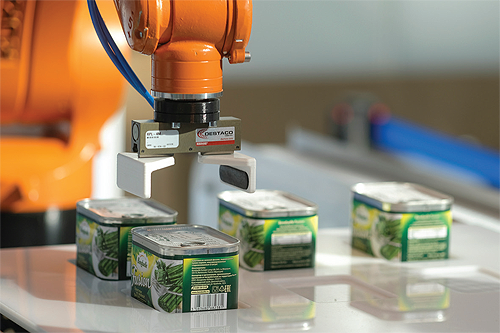Understand the benefits
Robots working alongside humans has undoubtedly permeated popular culture. What comes to mind when discussing robots? Most likely a popular tv or film characters such as R2D2 or Robocop. The depiction of robots as cyborgs has warped our view of what robots are, what they do and even what they look like. The reality of it is, that robots are being applied to many aspects of our day-to-day lives. Their capabilities are greater than ever before and uptake over the last few years has simply exploded. The food and drink industry is a prime example. Here, robots are being used to carry out tasks previously carried by humans, but in just a fraction of the time it would take a human. Robots are being applied to the food and beverage industry to assist in functions including; packing, handling, quality control and even maintenance.
The explosion of ‘cobotics’
Like many industrial processes, food and drink production is always at risk from human error, which can cause downtime, poor quality and product loss, ultimately increasing costs. To  minimise these risks and protect the production line, we are seeing the introduction of ‘cobotics’ – compact, easy-to-use and collaborative robots to work alongside humans.
minimise these risks and protect the production line, we are seeing the introduction of ‘cobotics’ – compact, easy-to-use and collaborative robots to work alongside humans.
As automation developers introduce better sensing capability and more responsive safety systems, the application of robotic equipment in this space will only increase – paving the way for improved interaction so that complex processes can be completed faster, more easily and more safely.
With this change comes an additional benefit for a skills-poor industry struggling to attract engineering expertise. The cobotics movement doesn’t replace humans, rather it simply frees up highly skilled workers time for more value-add activity.
Minimising the risks
With the collaboration of robots and humans becoming increasingly a focus point for UK food production lines and supply chains, we are beginning to see how this collaboration can minimise risks to employees working on the factory floor. Robots are able to perform more dangerous and repetitive jobs that can often be hazardous for humans, such cutting and slicing. In turn, this allows workers to apply their skills elsewhere. It also eases the social implications of the trend, ensuring the two parties can work in harmony towards productivity goals, while tackling the problem of engineering expertise retiring out of the workforce.
An example of robots’ capabilities to work alongside humans is the meat packing process. This involves handling and sorting products with a high degree of variability. Such differences are only visible to highly trained individuals and have not yet been mastered by machines.
However, the repetitive nature of the physical packaging of the meat is far more effectively performed by robots. This is a situation in which humans and robots can work on the same production line to create an environment with a greater level of flexibility, measurability and ultimately high quality.
In addition, with increasingly sophisticated sensors and more highly functional robotic equipment, the collaboration between humans and machines on the factory floor is imperative to ensure uniformity and efficiency. This is because robots not only reduce the chances of human error, but also because they manage resources to achieve the best margin. For example, food manufacturers such as bakers have started to notice increased productivity and quality as a result of incorporating smart technologies into their equipment. Connecting these devices has shown it is possible to control speed, precision and the volume of ingredients, combining high turnover with consistent quality.
The journey to success
For food manufacturers to ensure that they are getting the most out of their food lines, it’s important that they implement robotics and analytics. Ultimately, the only way to protect the food line from human error or equipment failure is to gather a greater insight into processes – with the capability to react in real-time. If we are to progress and take manufacturing to the next level, incorporating robotics into the production line is a vital part of this and the health and longevity of the sector relies on it.
Manufacturers ought to be prioritising the safety of their staff in these robot-human collaboration scenarios. To do this, manufacturers will need to work to upskill staff on how to mitigate the risk of robots on the factory floor – all supported with advancements in technology. As our capabilities continue to grow, advances in computer-vision, information technology and engineering can enable manufacturers to deliver real-time information and guidance at the point of use. Thanks to real-time insights, operators on the factory floor are kept up to date at all times, ensuring the appropriate action is taken should a risk be identified.
For the ‘cobotics’ movement to grow into a huge success, it’s time we work on educating our workforce as to its benefits. With a greater understanding, will come a greater implementation of the technology. It’s time we start reaping the benefits of greater efficiency, profitability and performance in the food and drink industry.
Martin Walder
Martin Walder is VP Industry at Schneider Electric. Schneider believes access to energy and digital is a basic human right. It provides energy and automation digital solutions for efficiency and sustainability. It combines world-leading energy technologies, real-time automation, software and services into integrated solutions for Homes, Buildings, Data Centres, Infrastructure and Industries.
www.se.com